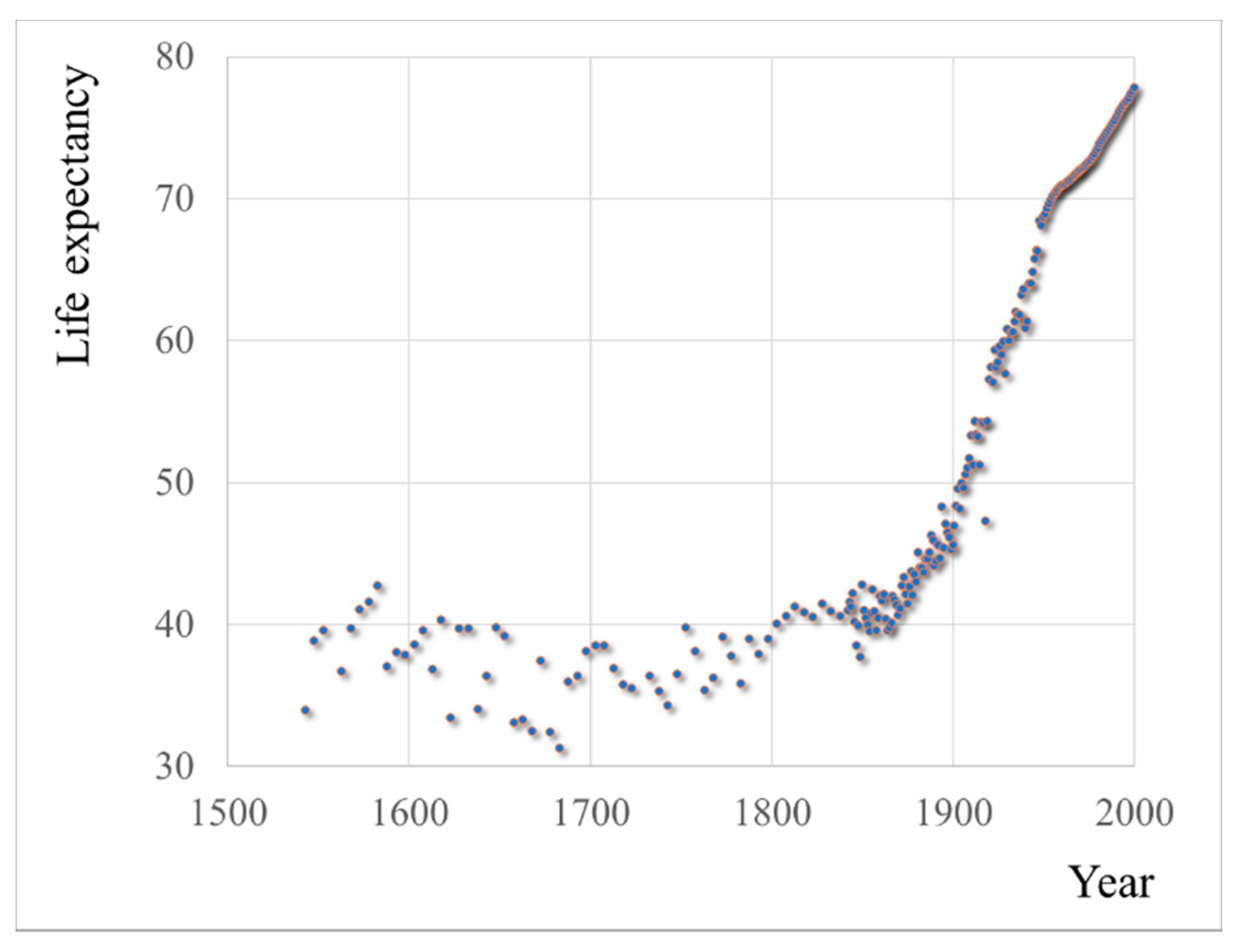Stratification: An Entropic View of Society’s Structure
Abstract
«τῷ γὰρ ἔχοντι παντὶ δοθήσεται καὶ περισσευθήσεται, ἀπὸ δὲ τοῦ μὴ ἔχοντος καὶ ὃ ἔχει ἀρθήσεται ἀπ αὐτοῦ» (Καινή Διαθήκη, Κατά Ματθαίον 25:29) [1]
“For everyone who has, will be given more, and he will have an abundance. Whoever does not have, even what he has will be taken from him.” (New Testament, Matthew 25:29)
1. Introduction
Entropy and its ability to increase (as contrasted to energy and other quantities that are conserved) is the driving force of change. This property of entropy has seldom been acknowledged; instead in common perception entropy is typically identified with disorganization and deterioration as if change can only have negative consequences [44].
2. Prosperity: The True Wealth
2.1. Water
2.2. Food
2.3. Energy
2.4. Validation of Energy as Proxy of Wealth
3. Stratification and Entropy
3.1. Prehistorc Societies
3.2. Entropic Analysis
The entropy retains its probabilistic interpretation as a measure of uncertainty … [T]he tendency of entropy to reach a maximum is the driving force of natural change. This tendency is formalized as the principle of maximum entropy, which can be regarded both as a physical (ontological) principle obeyed by natural systems, as well as a logical (epistemological) principle applicable in making inference about natural systems.
3.3. Antiquity and Medieval Societies
3.4. Modern Societies
4. Discussion
Consider that the two peak years of inequality over the past century—when the top 1 percent garnered more than 23 percent of total income—were 1928 and 2007. Each of these periods was preceded by substantial increases in borrowing, which ended notoriously in the Great Crash of 1929 and the near-meltdown of 2008.
The systemic socioeconomic problems are evoking such social discontent that they require special attention and real solutions. The dangerous illusion that they may be ignored or pushed into the corner is fraught with serious consequences. In this case, society will still be divided politically and socially.
5. Conclusions
Assumptions about human behavior that members of market societies believe to be universal, that humans are naturally competitive and acquisitive, and that social stratification is natural, do not apply to many hunter-gatherer peoples.
Author Contributions
Funding
Institutional Review Board Statement
Informed Consent Statement
Data Availability Statement
Acknowledgments
Conflicts of Interest
References
- Holy Bible, New Testament, Mathew 25. pp. 14–30. Available online: http://www.apostoliki-diakonia.gr/bible/bible.asp?contents=new_testament/contents_mathaiou.asp&main=mathaiou&file=1.1.25.htm (accessed on 15 December 2020).
- Milanovic, B. Global Income Inequality by the Numbers: in History and Now, Policy Research Working Paper 6259, The World Bank Development Research Group Poverty and Inequality Team. November 2012. Available online: http://documents1.worldbank.org/curated/en/959251468176687085/pdf/wps6259.pdf (accessed on 5 October 2020).
- Haitovsky, Y. Statistical Analysis, Special Problems of: Grouped Observations. In International Encyclopedia of the Social & Behavioral Sciences; Smelser, N.J., Baltes, P.B., Eds.; Elsevier: Pergamon, Turkey, 2001; pp. 14995–15002. ISBN 9780080430768. [Google Scholar] [CrossRef]
- Smith, A. The Wealth of Nations; W. Strahan and T. Cadell: London, UK, 1776. [Google Scholar]
- Phillipson, N. Adam Smith: An Enlightened Life; Yale University Press: New Haven, CT, USA, 2010. [Google Scholar]
- Gray, A. The Socialist Tradition: Moses to Lenin; Longmans, Green and Co.: New York, NY, USA, 1946; Available online: https://doi.org/10.1017/S0022050700053481 (accessed on 1 March 2021).
- Galbraith, J.K. Economics in Perspective: A Critical History; Houghton Mifflin: Boston, MA, USA, 1987. [Google Scholar]
- Malthus, T.R. An Essay on the Principle of Population; J. Johnson: London, UK, 1798. [Google Scholar]
- Darwin, C. On the Origin of Species; John Murray: London, UK, 1859. [Google Scholar]
- Rogers, J.A. Darwinism and social Darwinism. J. Hist. Ideas 1972, 333, 265–280. [Google Scholar] [CrossRef]
- Hawkins, M.; Hawkins, M. Social Darwinism in European and American Thought, 1860–1945: Nature as Model and Nature as Threat; Cambridge University Press: Cambridge, UK, 1997. [Google Scholar]
- Marx, K. Capital. A Critique of Political Economy. In Das Kapital: Kritik der Politischen Oekonomie; Verlag von Otto Meissner: Hamburg, Germany, 1867; Volume 1. [Google Scholar]
- Marx, K. Critique of the Gotha Programme. Available online: https://www.marxists.org/archive/marx/works/1875/gotha/ch01.htm (accessed on 21 January 2021).
- Sitton, J.F. Critique of the Gotha Programme. In Marx Today; Sitton, J.F., Ed.; Palgrave Macmillan: New York, NY, USA, 2010. [Google Scholar] [CrossRef]
- Keynes, J.M. The General Theory of Employment, Interest and Money; Palgrave Macmillan: London, UK, 1936. [Google Scholar]
- Friedman, M. A Program for Monetary Stability; Fordham University Press: New York, NY, USA, 1960. [Google Scholar]
- Hayek, F.A. The Constitution of Liberty; University of Chicago Press: Chicago, IL, USA, 1960. [Google Scholar]
- Hasan, Z. Democracy and the Crisis of Inequality; Primus Books: Delhi, India, 2014. [Google Scholar]
- Rodney, W. How Europe Underdeveloped Africa; Bogle-L’Ouverture Publications: London, UK, 1972. [Google Scholar]
- Richard, W. Tresch, Chapter 4—The Social Welfare Function in Policy Analysis. In Tresch, Public Finance, 3rd ed.; Richard, W., Ed.; Academic Press: Cambridge, MA, USA, 2015; pp. 57–78. ISBN 9780124158344. [Google Scholar] [CrossRef]
- Lorenz Curve. Available online: https://www.sciencedirect.com/topics/economics-econometrics-and-finance/lorenz-curve (accessed on 5 October 2020).
- Bellù, L.G.; Liberati, P. Charting Income Inequality. The Lorenz Curve, Food and Agriculture Organization of the United Nations, FAO. 2005. Available online: http://www.fao.org/3/a-am391e.pdf (accessed on 28 December 2020).
- Income Inequality. Available online: https://ourworldindata.org/income-inequality (accessed on 5 October 2020).
- Gini Index. Available online: https://www.investopedia.com/terms/g/gini-index.asp (accessed on 5 October 2020).
- Bellù, L.G.; Liberati, P. Inequality Analysis. The Gini Index, Food and Agriculture Organization of the United Nations, FAO. 2006. Available online: http://www.fao.org/3/a-am352e.pdf (accessed on 28 December 2020).
- Atkinson, A.B.; Bourguignon, F. Income Distribution. In International Encyclopedia of the Social & Behavioral Sciences; Smelser, N.J., Baltes, P.B., Eds.; Elsevier: Amsterdam, The Netherlands, 2001; pp. 7265–7271. ISBN 9780080430768. [Google Scholar] [CrossRef]
- Morelli, S.; Smeeding, T.; Thompson, J. Chapter 8—Post-1970 Trends in Within-Country Inequality and Poverty: Rich and Middle-Income Countries. In Atkinson, François Bourguignon, Handbook of Income Distribution; Anthony, B., Ed.; Elsevier: Amsterdam, The Netherlands, 2015; Volume 2, pp. 593–696. ISSN 1574-0056. ISBN 9780444594303. [Google Scholar] [CrossRef]
- Förster, M.F.; Tóth, I.G. Chapter 19—Cross-Country Evidence of the Multiple Causes of Inequality Changes in the OECD Area. In Atkinson, François Bourguignon, Handbook of Income Distribution; Anthony, B., Ed.; Elsevier: Amsterdam, The Netherlands, 2015; Volume 2, pp. 1729–1843. ISSN 1574-0056. ISBN 9780444594303. [Google Scholar] [CrossRef]
- Income Distribution, Redefining Capitalism in Global Economic Development. 2017. Available online: https://www.sciencedirect.com/topics/economics-econometrics-and-finance/income-distribution (accessed on 5 October 2020).
- Roine, J.; Waldenström, D. Chapter 7—Long-Run Trends in the Distribution of Income and Wealth. In Atkinson, François Bourguignon, Handbook of Income Distribution; Anthony, B., Ed.; Elsevier: Amsterdam, The Netherlands, 2015; Volume 2, pp. 469–592. ISSN 1574-0056. ISBN 9780444594303. [Google Scholar] [CrossRef]
- Piketty, T. Theories of Persistent Inequality and Intergenerational Mobility. In Handbook of Income Distribution; Elsevier: Amsterdam, The Netherlands, 2000; pp. 429–476. [Google Scholar]
- Jones, C.I. Simple Models of Pareto Income and Wealth Inequality. 2014. Available online: http://web.stanford.edu/~chadj/SimpleParetoJEP.pdf (accessed on 25 December 2020).
- Pareto, V. Manual of Political Economy, with an Introduction to Social Science (Manuale di Economia Politica, con una Introduzione alla Scienza Sociale); Società Editrice Libraria: Milano, Italy, 1919. [Google Scholar]
- Blanchet, T.; Fournier, J.; Piketty, T. Generalized Pareto Curves: Theory and Applications, WID.World Working Paper, 2017/3. Available online: https://wid.world/document/blanchet-t-fournier-j-piketty-t-generalized-pareto-curves-theory-applications-2017/ (accessed on 7 February 2021).
- Ryu, H.K. Maximum Entropy Estimation of Income Distributions from Bonferroni Indices. In Modeling Income Distributions and Lorenz Curves. Economic Studies in Equality, Social Exclusion and Well-Being; Chotikapanich, D., Ed.; Springer: New York, NY, USA, 2008; Volume 5. [Google Scholar] [CrossRef]
- Ryu, H.K. A bottom poor sensitive Gini coefficient and maximum entropy estimation of income distributions. Econ. Lett. 2013, 118, 370–374. [Google Scholar] [CrossRef]
- Fu, Q.; Villas-Boas, S.B.; Judge, G. Entropy-based China income distributions and inequality measures. China Econ. J. 2019, 12, 352–368. [Google Scholar] [CrossRef]
- Dinga, E.; Tănăsescu, C.-R.; Ionescu, G.-M. Social Entropy and Normative Network. Entropy 2020, 22, 1051. Available online: https://www.mdpi.com/1099-4300/22/9/1051 (accessed on 5 October 2020). [CrossRef]
- Davis, P.J. Entropy and Society: Can the Physical/Mathematical Notions of Entropy Be Usefully Imported into the Social Sphere? J. Humanist. Math. 2011, 1, 119–136. Available online: https://scholarship.claremont.edu/jhm/vol1/iss1/9 (accessed on 7 February 2021). [CrossRef]
- Mayer, A.L.; Donovan, R.P.; Pawlowski, C.W. Information and entropy theory for the sustainability of coupled human and natural systems. Ecol. Soc. 2014, 19, 11. [Google Scholar] [CrossRef]
- Johansson, A. Entropy and the cost of complexity in industrial production, Exergy. Int. J. 2002, 2, 295–299. [Google Scholar] [CrossRef]
- Netto, V.M.; Meirelles, J.; Ribeiro, F.L. Social Interaction and the City: The Effect of Space on the Reduction of Entropy. Complexity 2017. [Google Scholar] [CrossRef]
- Mavrofides, T.; Kameas, A.; Papageorgiou, D.; Los, A. On the Entropy of Social Systems: A Revision of the Concepts of Entropy and Energy in the Social Context. Syst. Res. 2011, 28, 353–368. [Google Scholar] [CrossRef]
- Koutsoyiannis, D. Stochastics of Hydroclimatic Extremes—A Cool Look at Risk; National Technical University of Athens: Athens, Greece, 2020; 330p. [Google Scholar]
- Dyble, M.; Salali, G.D.; Chaudhary, N.; Page, A.; Smith, D.; Thompson, J.; Vinicius, L.; Mace, R.; Migliano, A.B. Sex equality can explain the unique social structure of hunter-gatherer bands. Science 2015, 348, 796–798. [Google Scholar] [CrossRef]
- Woodburn, J. Egalitarian Societies, Man. 1982, pp. 431–451. Available online: http://links.jstor.org/sici?sici=0025-1496%28198209%292%3A17%3A3%3C431%3AES%3E2.0.CO%3B2-W (accessed on 14 February 2021).
- Lewis, H.; Vinicius, L.; Strods, J.; Ruth, M.; Bamberg Migliano, A. High mobility explains demand sharing and enforced cooperation in egalitarian hunter-gatherers. Nat. Commun. 2014, 5, 5789. [Google Scholar] [CrossRef]
- Gowdy, J. Hunter-Gatherers and the Mythology of the Market. The Cambridge Encyclopedia of Hunters and Gatherers; Cambridge University Press: Cambridge, UK, 2006; pp. 391–393. ISBN 0-521-60919-4. [Google Scholar]
- Smith, E.A.; Hill, K.; Marlowe, F.; Nolin, D.; Wiessner, P.; Gurven, M.; Bowles, S.; Borgerhoff Mulder, M.; Hertz, T.; Bellj, A. Wealth transmission and inequality among hunter-gatherers. Curr. Anthropol. 2010, 51, 19–34. [Google Scholar] [CrossRef]
- Orans, M. Surplus. Hum. Organ. 1966, 25, 24–32. [Google Scholar] [CrossRef]
- Angle, J. The Surplus Theory of Social Stratification and the Size Distribution of Personal Wealth. Soc. Forces 1986, 65, 293–326. [Google Scholar] [CrossRef]
- Herskovits, M.J. The Economic Life of Primitive Peoples; Alfred A. Knopf, Inc.: New York, NY, USA, 1940. [Google Scholar]
- First Economic Adjustment Programme for Greece. Available online: https://en.wikipedia.org/wiki/First_Economic_Adjustment_Programme_for_Greece (accessed on 28 December 2020).
- Labrianidis, L.; Pratsinakis, M. Greece’s New Emigration at Times of Crisis. GreeSE Papers (99). Hellenic Observatory, LSE, London. 2016. Available online: http://eprints.lse.ac.uk/66811/ (accessed on 2 January 2021).
- Bao, X.D. The conception of healthcare in Confucianism. Zhonghua Yi Shi Za Zhi 2003, 33, 24–26. [Google Scholar]
- Guo, Z. Chinese Confucian culture and the medical ethical tradition. J. Med. Ethics 1995, 21, 239–246. [Google Scholar] [CrossRef]
- Water, Food and Energy. Available online: https://www.unwater.org/water-facts/water-food-and-energy (accessed on 2 January 2021).
- Life Expectancy. Available online: https://ourworldindata.org/life-expectancy (accessed on 5 October 2020).
- Mamassis, N.; Efstratiadis, A.; Dimitriadis, P.; Iliopoulou, T.; Ioannidis, R.; Koutsoyiannis, D. Water and Energy, Handbook of Water Resources Management: Discourses, Concepts and Examples; Bo-gardi, J., Wasantha, K.D., Nandalal, R.R.P., van Nooyen, R., Bhaduri, A., Eds.; Springer Nature: Cham, Switzerland, 2020; Chapter 20. [Google Scholar]
- Alcamo, J.; Döll, P.; Henrichs, T.; Kaspar, F.; Lehner, B.; Rösch, T.; Siebert, S. Development and testing of the WaterGAP 2 global model of water use and availability. Hydrol. Sci. J. 2003, 48, 317–337. [Google Scholar] [CrossRef]
- Aus der Beek, T.; Flörke, M.; Lapola, D.M.; Schaldach, R.; Voß, F.; Teichert, E. Modelling historical and current irrigation water demand on the continental scale: Europe. Adv. Geosci. 2010, 27, 79–85. [Google Scholar] [CrossRef]
- United Nations. 2019 Revision of World Population Prospects. Available online: https://population.un.org/wpp/ (accessed on 30 November 2020).
- Total Population. Available online: https://clio-infra.eu/Indicators/TotalPopulation.html (accessed on 30 November 2020).
- AQUASTAT: Food and Agriculture Organization of the United Nations. Available online: http://www.fao.org/nr/water/aquastat/data/query/index.html (accessed on 5 November 2020).
- Gleick, P.H. Basic water requirements for human activities: Meeting basic needs. Water Int. 1996, 21, 83–92. [Google Scholar] [CrossRef]
- FAOSTAT, United Nations Food and Agricultural Organization (FAO). Available online: http://www.fao.org/faostat/en/#data/FBS (accessed on 12 October 2020).
- Bank of England, Home Statistics Research Datasets. Available online: https://www.bankofengland.co.uk/statistics/research-datasets (accessed on 25 November 2020).
- Ostwald, W. Energetische Grundlagen der Kulturwissenschaft; Creative Media Partners, LLC.: Sacramento, CA, USA, 2015. [Google Scholar]
- Lévi-Strauss, C. Tristes Tropiques; Atheneum: New York, NY, USA, 1963. [Google Scholar]
- Lévi-Strauss, C. Structural Anthropology; Basic Books: New York, NY, USA, 1963. [Google Scholar]
- Lévi-Strauss, C. Social structure. In Anthropology Today: Selections; Tax, S., Ed.; University of Chicago Press: Chicago, IL, USA, 2021; pp. 321–350. Available online: http://varenne.tc.columbia.edu/bib/info/levstcld062socistru.html (accessed on 25 January 2021).
- Xanthopoulos, T. Requiem with Crescendo, Homo Sapiens the Ultimate Genus of Human; National Technical University of Athens: Athens, Greece, 2020; Volume 1–3. [Google Scholar]
- Maddison Project Database. 2018. Available online: https://www.rug.nl/ggdc/historicaldevelopment/maddison/releases/maddison-project-database-2018 (accessed on 30 November 2020).
- Steam Turbines: How Big Can They Get? Available online: https://www.modernpowersystems.com/features/featuresteam-turbines-how-big-can-they-get/ (accessed on 5 October 2020).
- Smil, V. Conversion of Energy: People and Animals. In Cleveland, Encyclopedia of Energy; Cutler, J., Ed.; Elsevier: Amsterdam, The Netherlands, 2004; pp. 697–705. ISBN 9780121764807. [Google Scholar] [CrossRef]
- Smil, V. World History and Energy. In Cleveland, Encyclopedia of Energy; Cutler, J., Ed.; Elsevier: Amsterdam, The Netherlands, 2004; pp. 549–561. ISBN 9780121764807. [Google Scholar] [CrossRef]
- Sargentis, G.-F.; Iliopoulou, T.; Sigourou, S.; Dimitriadis, P.; Koutsoyiannis, D. Evolution of Clustering Quantified by a Stochastic Method—Case Studies on Natural and Human Social Structures. Sustainability 2020, 12, 7972. [Google Scholar] [CrossRef]
- Goldewijk, K.; Beusen, A.; van Drecht, G.; de Vos, M. The HYDE 3.1 spatially explicit database of human-induced global land-use change over the past 12,000 years. Glob. Ecol. Biogeogr. 2011, 20, 73–86. [Google Scholar] [CrossRef]
- Smith, A. Ancient and Traditional Agriculture, Pastoralism, and Agricultural Societies in Sub-Saharan Africa. Oxf. Res. Encycl. Environ. Sci. 2019. [Google Scholar] [CrossRef]
- Jiang, Y.; Zhang, Q.; Niu, J.; Wu, J. Pastoral Population Growth and Land Use Policy Has Significantly Impacted Livestock Structure in Inner Mongolia—A Case Study in the Xilinhot Region. Sustainability 2019, 11, 7208. [Google Scholar] [CrossRef]
- Davis, J.; Hatfield, R. The economics of mobile pastoralism: a global summary. Nomadic Peoples 2007, 11, 91–116. Available online: www.jstor.org/stable/43123794 (accessed on 12 December 2020). [CrossRef]
- Coughenour, M.B.; Ellis, J.E.; Swift, D.M.; Coppock, D.L.; Galvin, K.; McCabe, J.T.; Hart, T.C. Energy extraction and use in a nomadic pastoral ecosystem. Science 1985, 230, 619–625. [Google Scholar] [CrossRef]
- Singh, H.; Mishra, D.; Nahar, N.M. Energy use pattern in production agriculture of a typical village in arid zone, India. Energy Convers. Manag. 2002, 43, 2275–2286. [Google Scholar] [CrossRef]
- Canakci, M.; Topakci, M.; Akinci, I.; Ozmerzi, A. Energy use pattern of some field crops and vegetable production: Case study for Antalya Region, Turkey. Energy Convers. Manag. 2005, 46, 655–666. [Google Scholar] [CrossRef]
- Kander, A.; Warde, P. Energy Availability from Livestock and Agricultural Productivity in Europe, 1815–1913: A New Comparison. Econ. Hist. Rev. 2011, 64, 1–29. Available online: http://www.jstor.org/stable/27919479 (accessed on 30 November 2020). [CrossRef] [PubMed]
- Schnepf, R. Energy Use in Agriculture: Background and Issues, CRS Report for Congress, Received through the CRS Web. 2004. Available online: https://nationalaglawcenter.org/wp-content/uploads/assets/crs/RL32677.pdf (accessed on 5 October 2020).
- Vreni, J.-R.; Crump, L.; Abicho, A.A.; Abakar, A.A.; Mahamat, A., II; Bechir, M.; Eckert, S.; Engesser, M.; Schelling, E.; Zinsstag, J. Estimating population and livestock density of mobile pastoralists and sedentary settlements in the south-eastern Lake Chad area. Geospat. Health 2015, 10. [Google Scholar] [CrossRef]
- Sackett, R. Time, Energy, and the Indolent Savage. A Quantitative Cross-Cultural Test of the Primitive Affluence Hypothesis. Ph.D. Thesis, University of California, Oakland, CA, USA, 1996. [Google Scholar]
- Kander, A.; Warde, P. Number, Size and Energy Consumption of Draught Animals in European Agriculture, Working Paper, March 2009. Available online: https://histecon.fas.harvard.edu/energyhistory/data/warde_kander_working_paper_animals-mar09.pdf (accessed on 5 October 2020).
- Koutsoyiannis, D. Entropy production in stochastics. Entropy 2017, 19, 581. [Google Scholar] [CrossRef]
- Jaynes, E.T. Information theory and statistical mechanics. Phys. Rev. 1957, 106, 620–630. [Google Scholar] [CrossRef]
- Clausius, R. The Mechanical Theory of Heat: with Its Applications to the Steam-Engine and To the Physical Properties of Bodies; J. van Voorst: London, UK, 1867; Available online: http://books.google.gr/books?id=8LIEAAAAYAAJ (accessed on 5 February 2021).
- Koutsoyiannis, D. Entropy: From Thermodynamics to Hydrology. Entropy 2014, 16, 1287–1314. [Google Scholar] [CrossRef]
- Koutsoyiannis, D. On the book “Requiem with Crescendo” by T. Xanthopoulos. In Presentation of the Book “Requiem with Crescendo”; National Technical University of Athens: Athens, Greece, 2018. [Google Scholar] [CrossRef]
- Lenski, G.E. Power and Privilege: A Theory of Social Stratification; McGraw-Hill: New York, NY, USA, 1966. [Google Scholar]
- Collins, R. Theoretical Sociology; Harcourt College Pub: New York, NY, USA, 1988. [Google Scholar]
- Trigger, B.G. Understanding Early Civilizations: A Comparative Study; Cambridge University Press: New York, NY, USA, 2003. [Google Scholar]
- Henrich, J.; Boyd, R. Division of labor, economic specialization, and the evolution of social stratification. Curr. Anthropol. 2008, 49, 715–724. [Google Scholar] [CrossRef]
- Preston, S.H. Human mortality throughout history and prehistory. State Humanit. 1995, 15, 30–36. [Google Scholar]
- Edwards, C. The Impact of European Overseas Discoveries on Ship Design and Construction during the Sixteenth Century. GeoJournal 1992, 26, 443–452. [Google Scholar] [CrossRef]
- How Currency Works. Available online: https://money.howstuffworks.com/currency.htm (accessed on 15 December 2020).
- Russian President Putin Delivers Speech at Virtual World Economic Forum. Available online: http://thesaker.is/russian-president-putin-delivers-speech-at-virtual-world-economic-forum/. (accessed on 28 January 2021).
- Björn, H. Deprivation and Poverty: A Comparative Analysis of Sweden and Great Britain. Acta Sociol. 1996, 39, 141–168. Available online: www.jstor.org/stable/4194815 (accessed on 26 December 2020).
- UNU World Income Inequality Database—WIID. Available online: https://www.wider.unu.edu/database/wiid (accessed on 23 January 2021).
- Sweden. Available online: https://el.wikipedia.org/wiki/Σουηδία (accessed on 26 January 2021).
- Lazaretou, S. The Greek brain drain: the new pattern of Greek emigration during the recent crisis. Econ. Bull. 2016, 43, 31–53. [Google Scholar]
- Eurostat: Emigration by Age Group, Sex and Citizenship. Available online: http://appsso.eurostat.ec.europa.eu/nui/show.do?dataset=migr_emi1ctz&lang=en (accessed on 26 January 2021).
- Kathimerini: Where Are the Greek Immigrants Going? Available online: https://www.kathimerini.gr/society/873724/poy-pane-oi-ellines-metanastes/ (accessed on 26 January 2021).
- Hans Rosling’s 200 Countries, 200 Years, 4 Minutes—The Joy of Stats—BBC Four. Available online: https://youtu.be/jbkSRLYSojo (accessed on 26 January 2021).
- Oxfam, The Inequality Virus. Available online: https://www.oxfam.org/en/research/inequality-virus (accessed on 26 January 2021).
- Hofstede, G.; Bond, M.H. The Confucius connection: From cultural roots to economic growth. Organ. Dyn. 1988, 16, 5–21. [Google Scholar] [CrossRef]
- Pettman, R. Confucian Marxism. In Reason, Culture, Religion. Culture and Religion in International Relations; Palgrave Macmillan: New York, NY, USA, 2004. [Google Scholar] [CrossRef]
- Elliott, J.; Clark, B. Keynes’s “General Theory” and Social Justice. J. Post Keynes. Econ. 1987, 9, 381–394. Available online: http://www.jstor.org/stable/4538019 (accessed on 3 February 2021). [CrossRef]
- Reich, R.B. How to Shrink Inequality, The Nation 26 May 2014. Available online: https://www.thenation.com/article/archive/how-shrink-inequality/ (accessed on 3 February 2021).
- Hudson, M. Finance Capitalism vs. Industrial Capitalism, The Unz Review, An Alternative Media Selection, 29 January 2021. Available online: https://www.unz.com/mhudson/finance-capitalism-vs-industrial-capitalism-2/ (accessed on 5 February 2021).
- Roser, M. The Economies that Are Home to the Poorest Billions of People Need to Grow If We Want Global Poverty to Decline, 22 February 2021. Available online: https://ourworldindata.org/poverty-growth-needed (accessed on 25 February 2021).
- Lamper, M.; Inglehart, R.; Metaal, S.; Schoemaker, H.; Papadongonas, P. Covid Pandemic Ignites Fear, but Boosts Progressiveide Alsand Calls for Inclusive Economic Growth, Measuring the Pandemic’s Impact on Social Values, Emotions and Priorities in 24 Countries, Glocalities, 23 February 2021. Available online: https://glocalities.com/latest/reports/valuestrends (accessed on 25 February 2021).
- Xi Jinping’s Speech at the Virtual Davos Agenda Event. Available online: https://news.cgtn.com/news/2021-01-25/Full-text-Xi-Jinping-s-speech-at-the-virtual-Davos-Agenda-event-Xln4hwjO2Q/index.html (accessed on 26 January 2021).
- The IMF and Income Inequality. Available online: https://www.imf.org/en/Topics/Inequality (accessed on 26 January 2021).
- Oxfam, the Power of People against Povery. Available online: https://www.oxfam.org/en (accessed on 26 January 2021).
- Koutsoyiannis, D. Rethinking climate, climate change, and their relationship with water. Water 2021, 13, 849. [Google Scholar] [CrossRef]
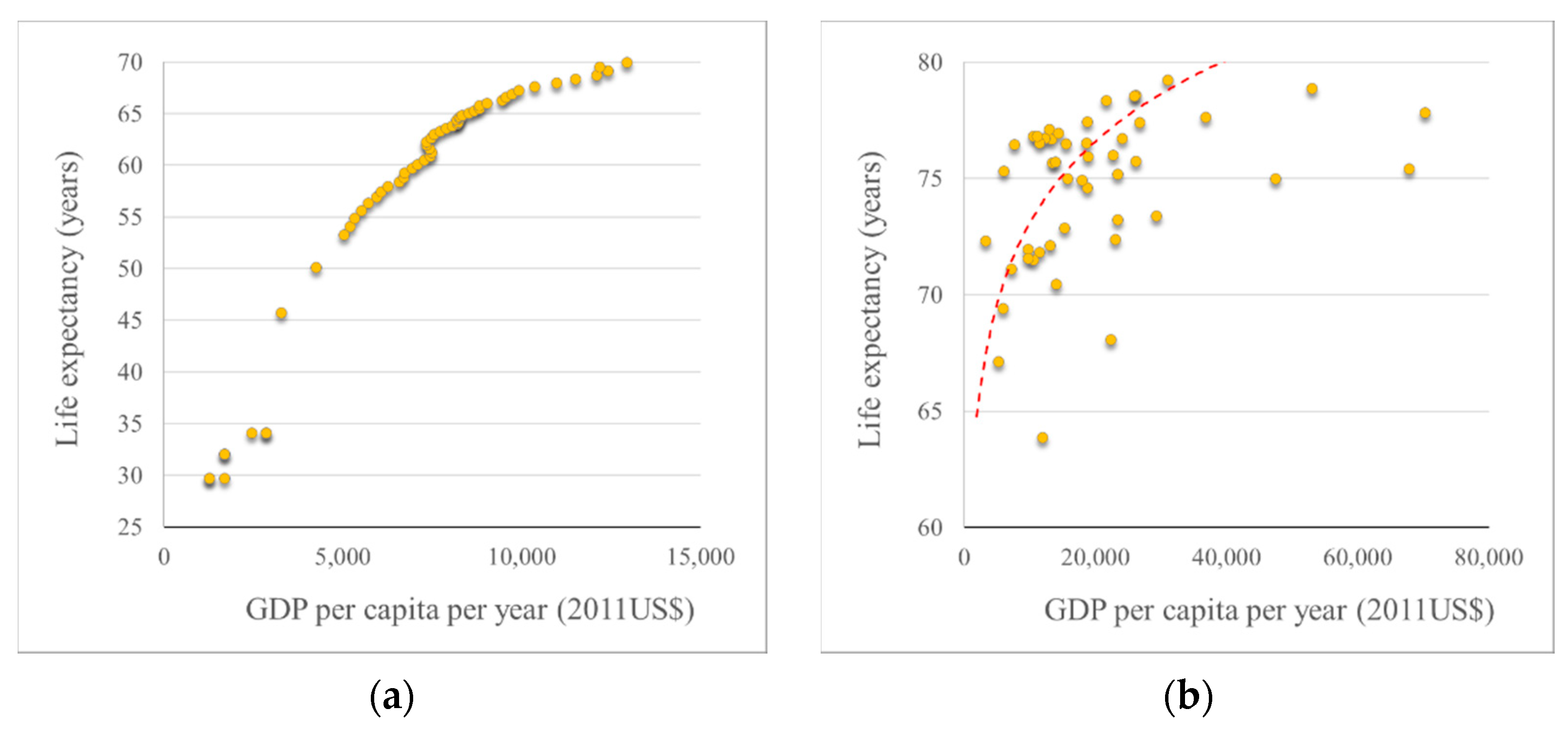
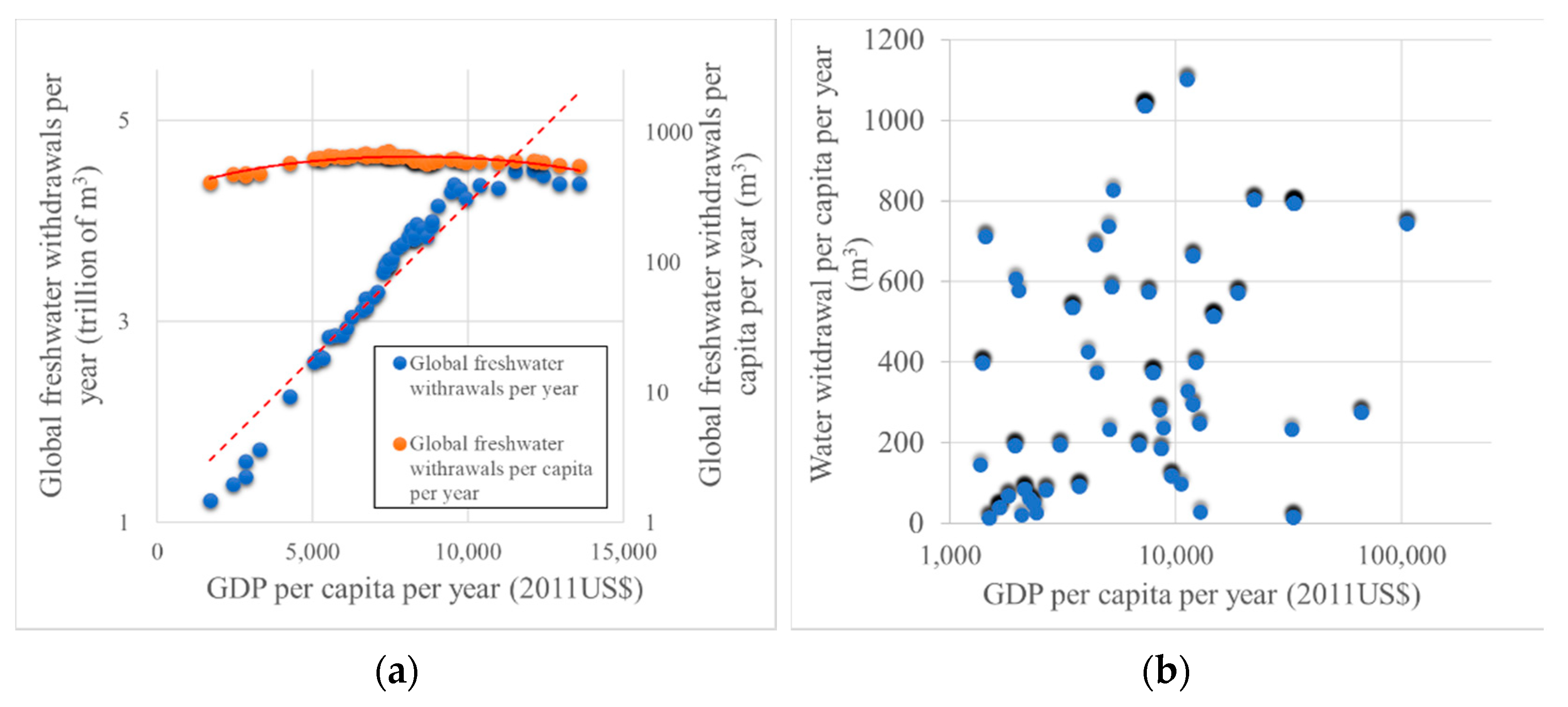
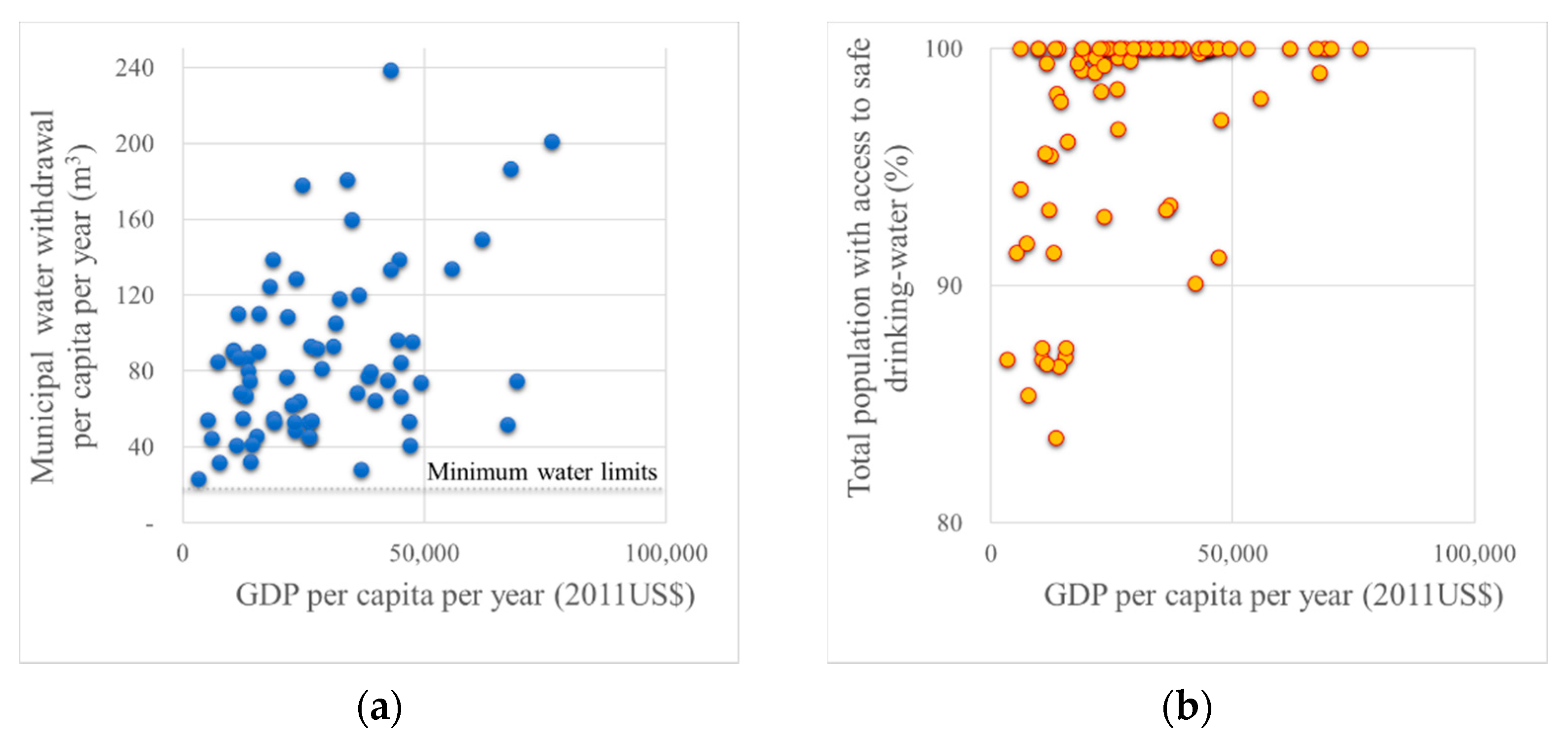
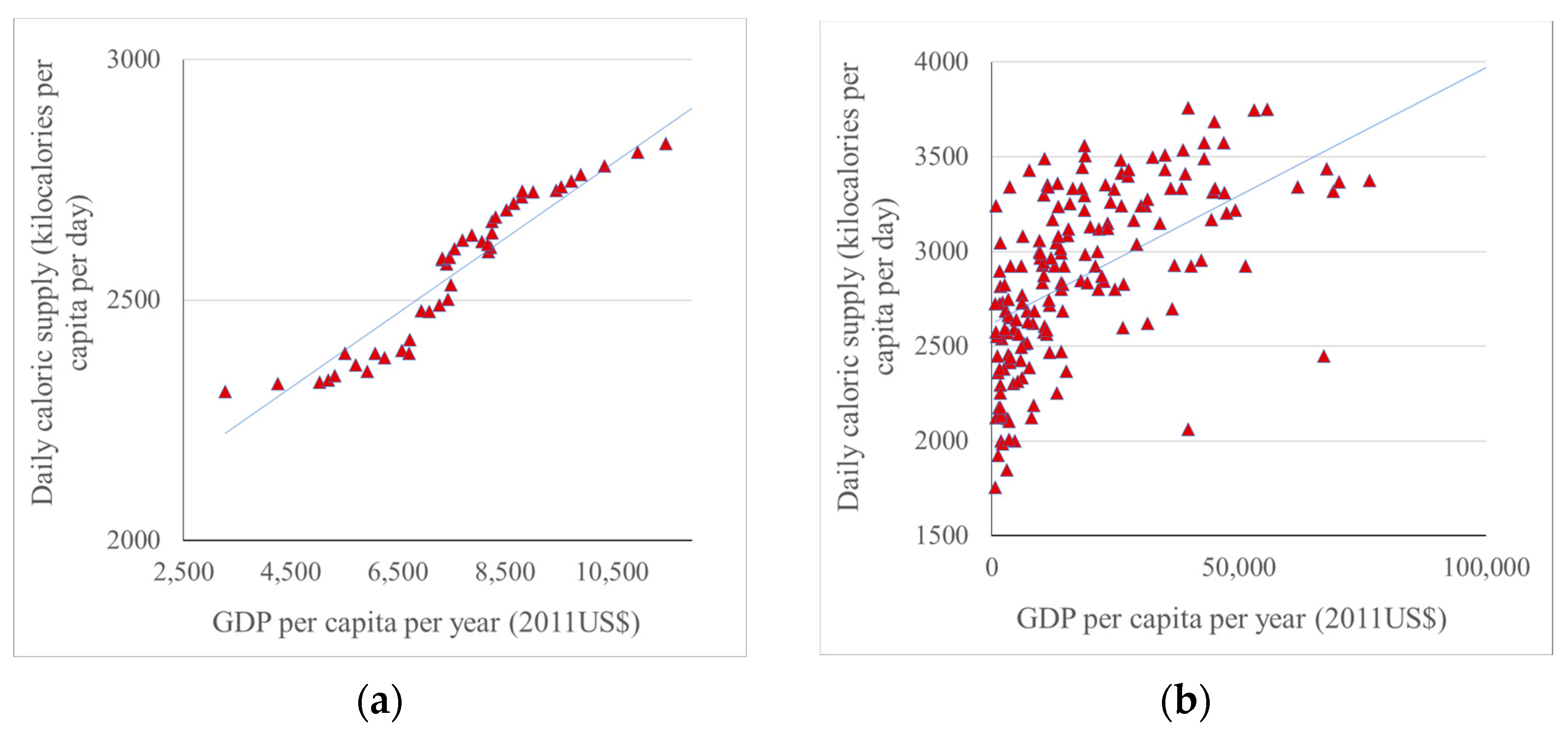
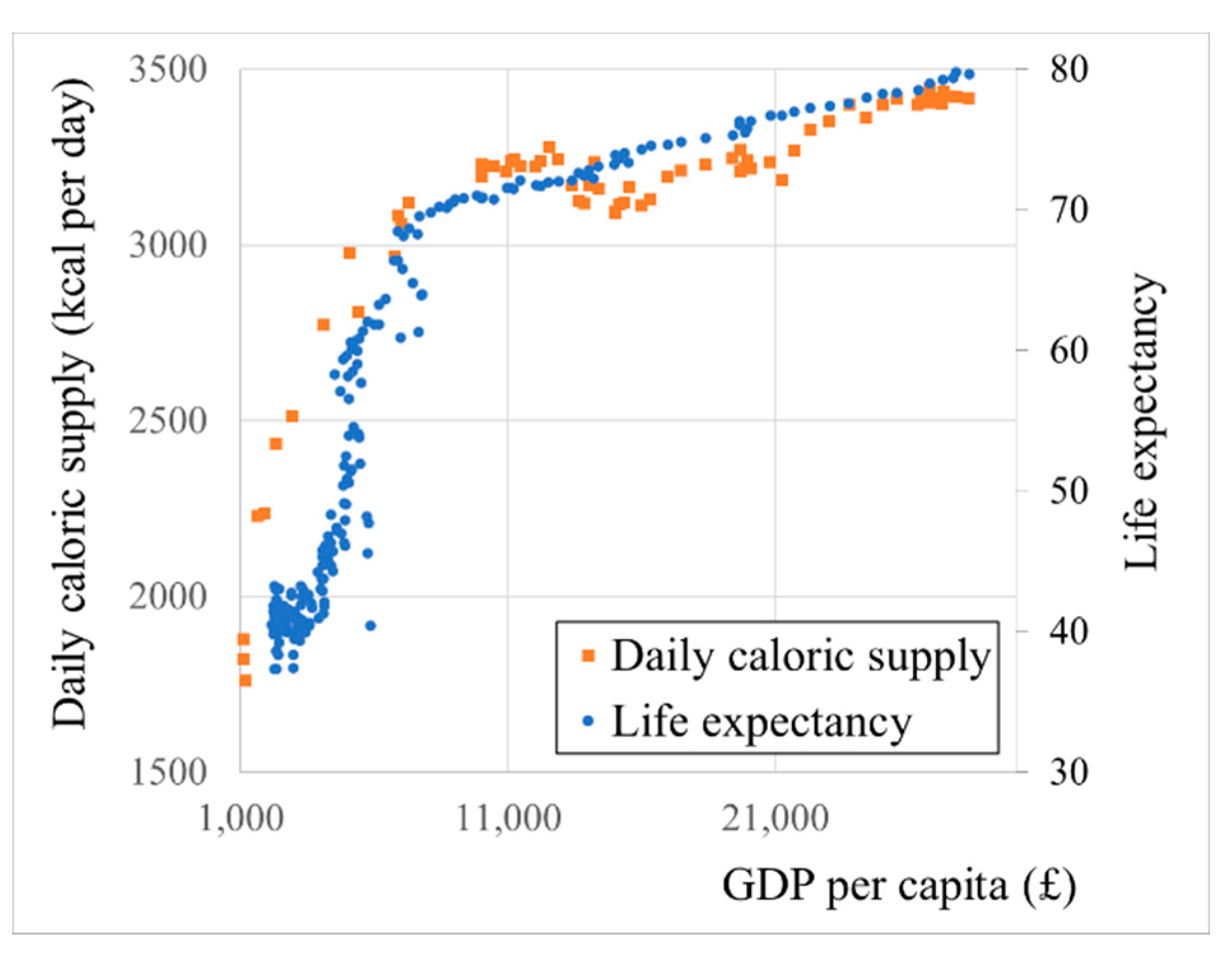
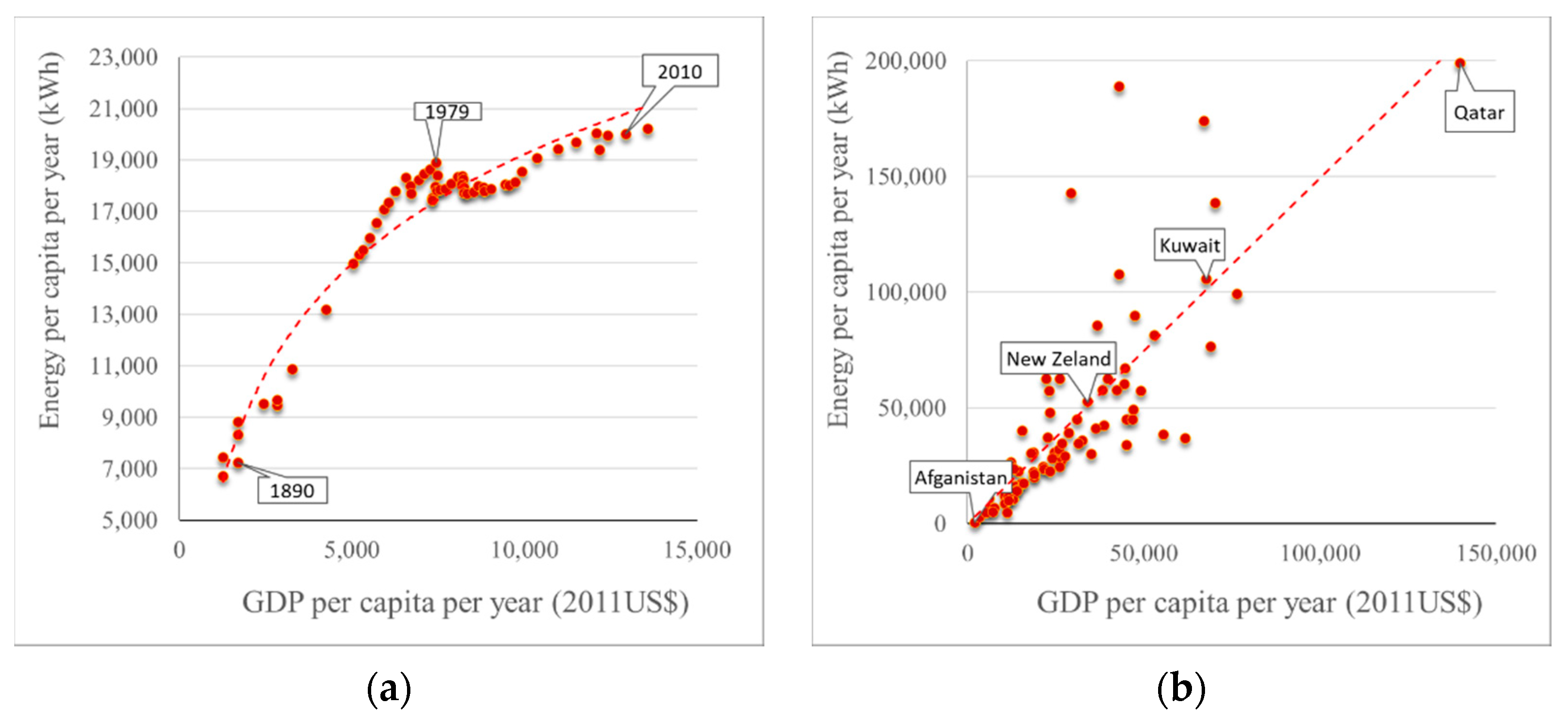
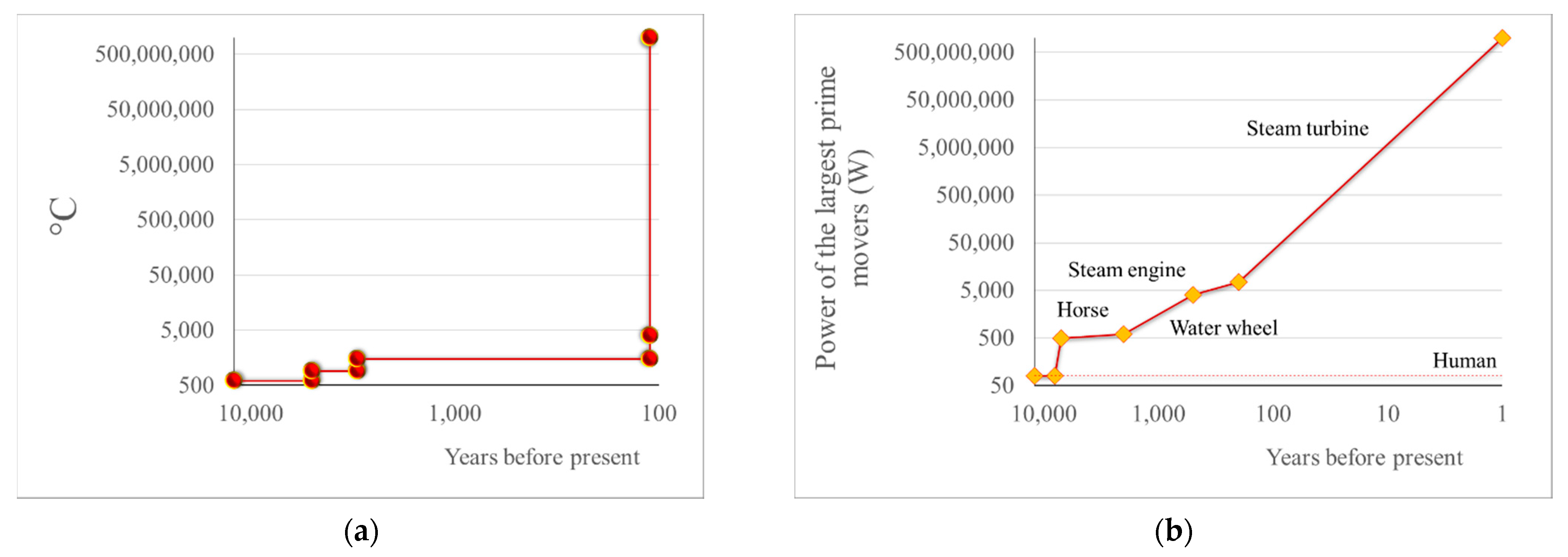

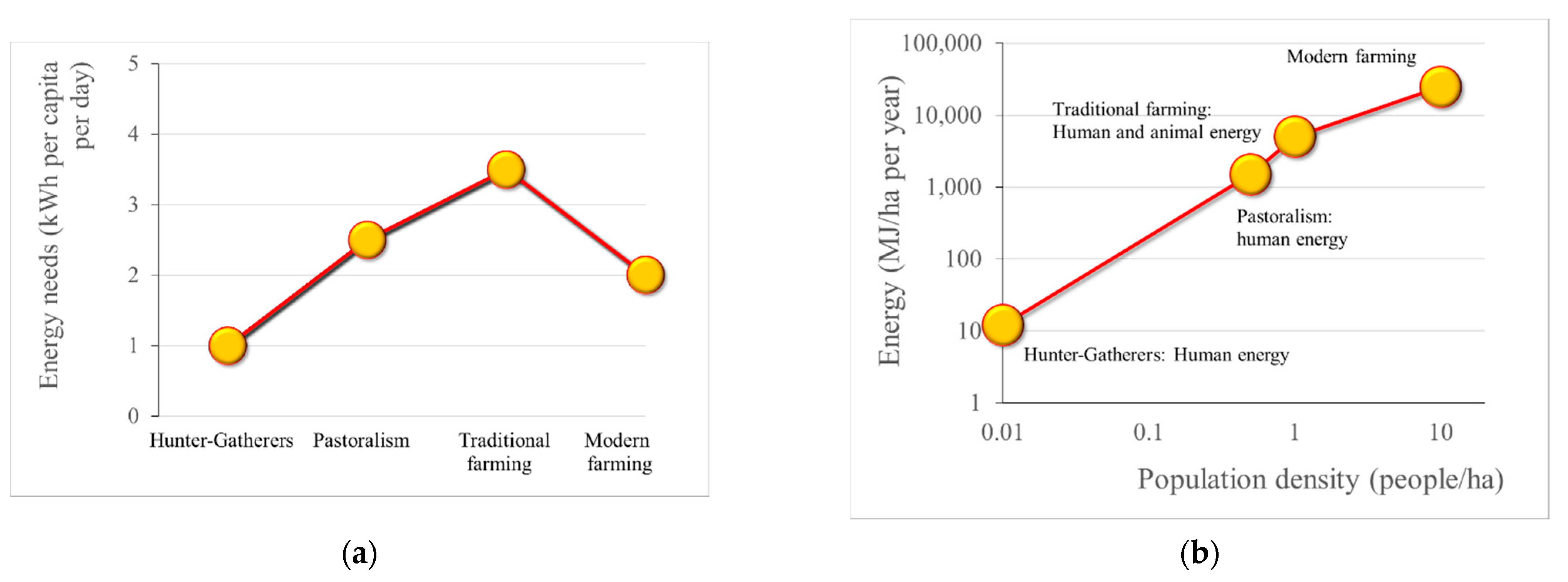
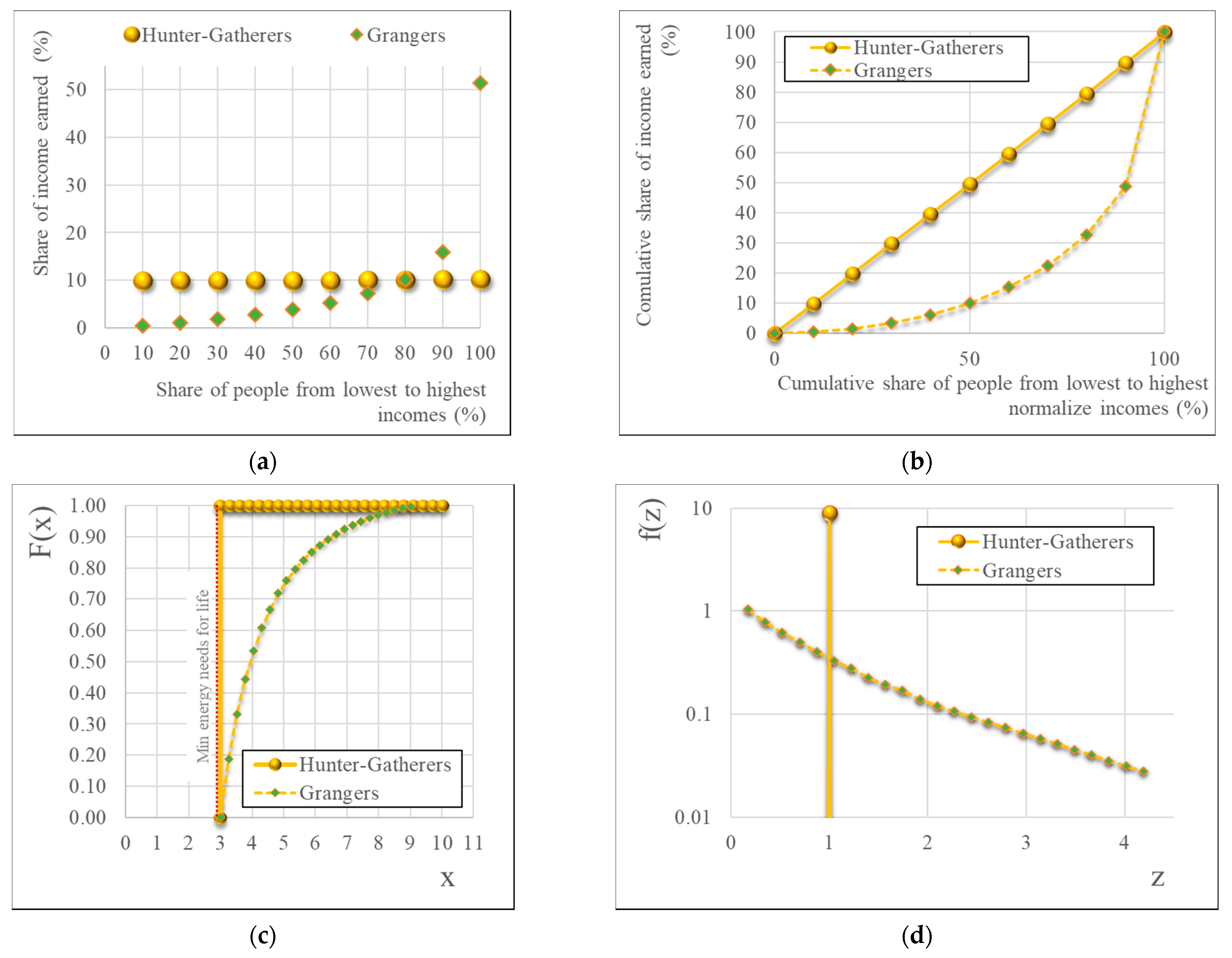
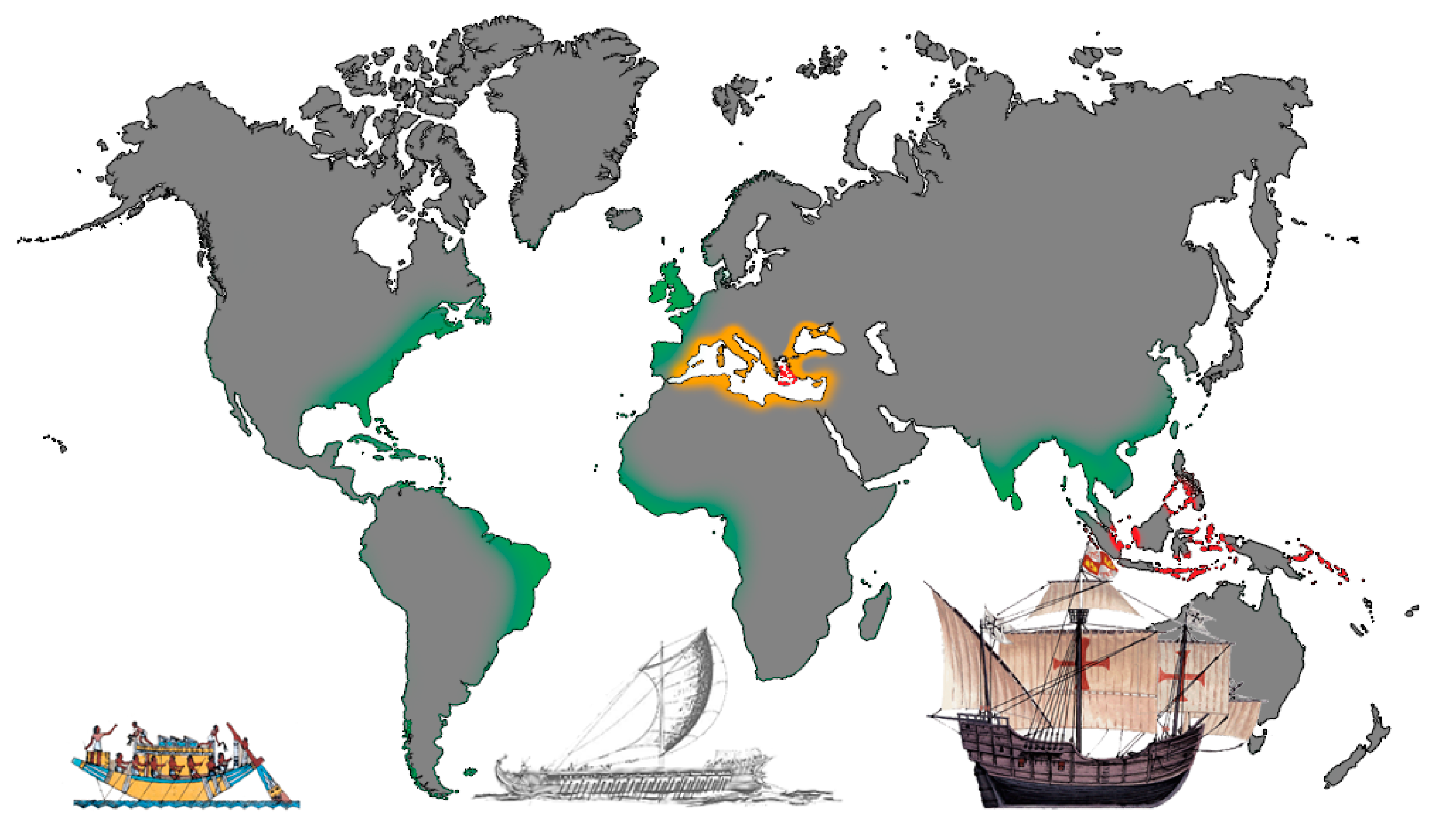
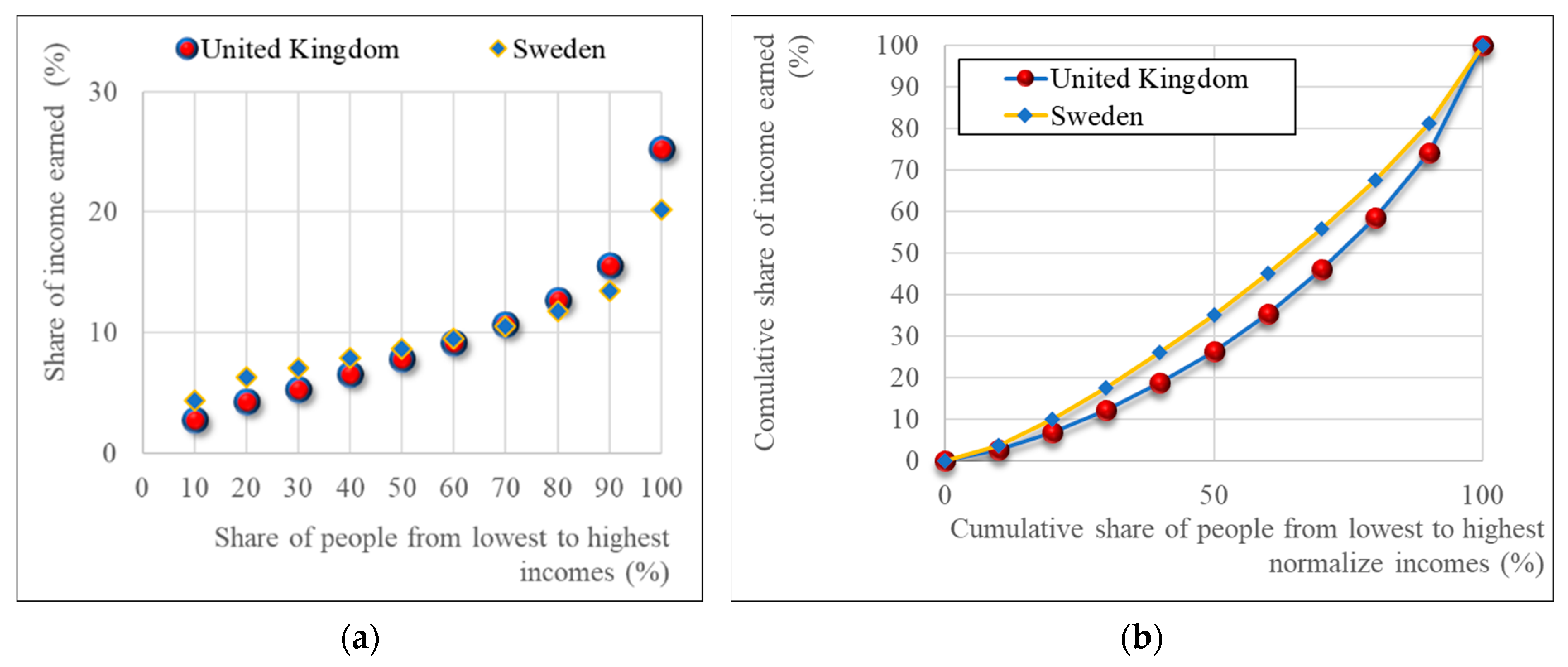
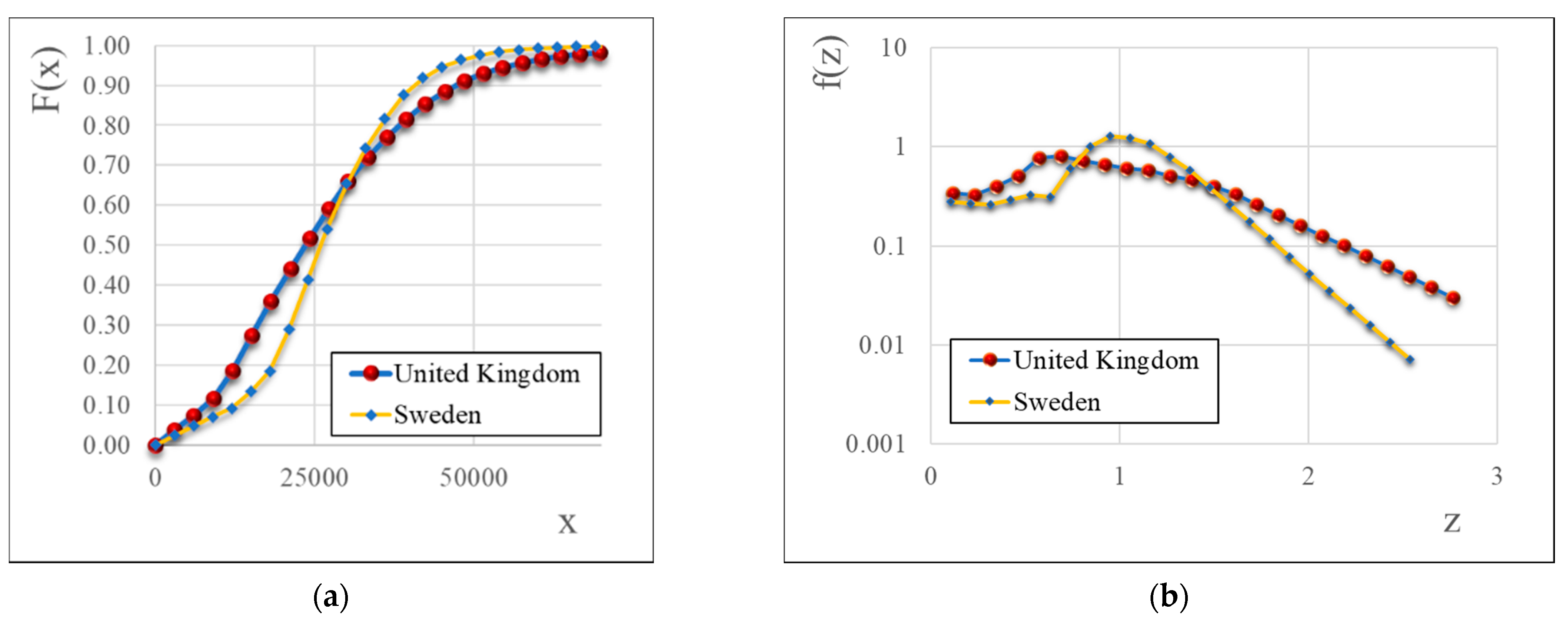
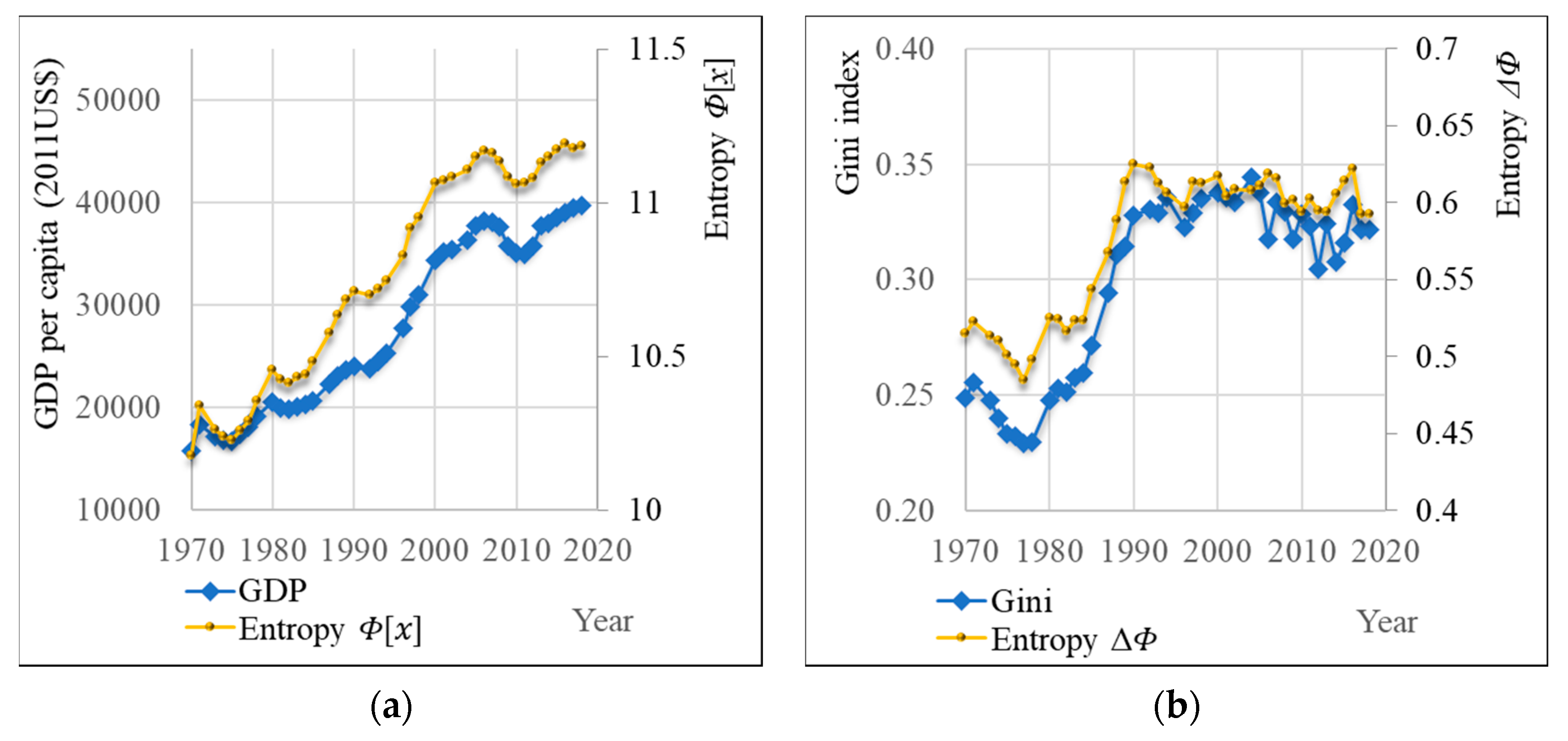
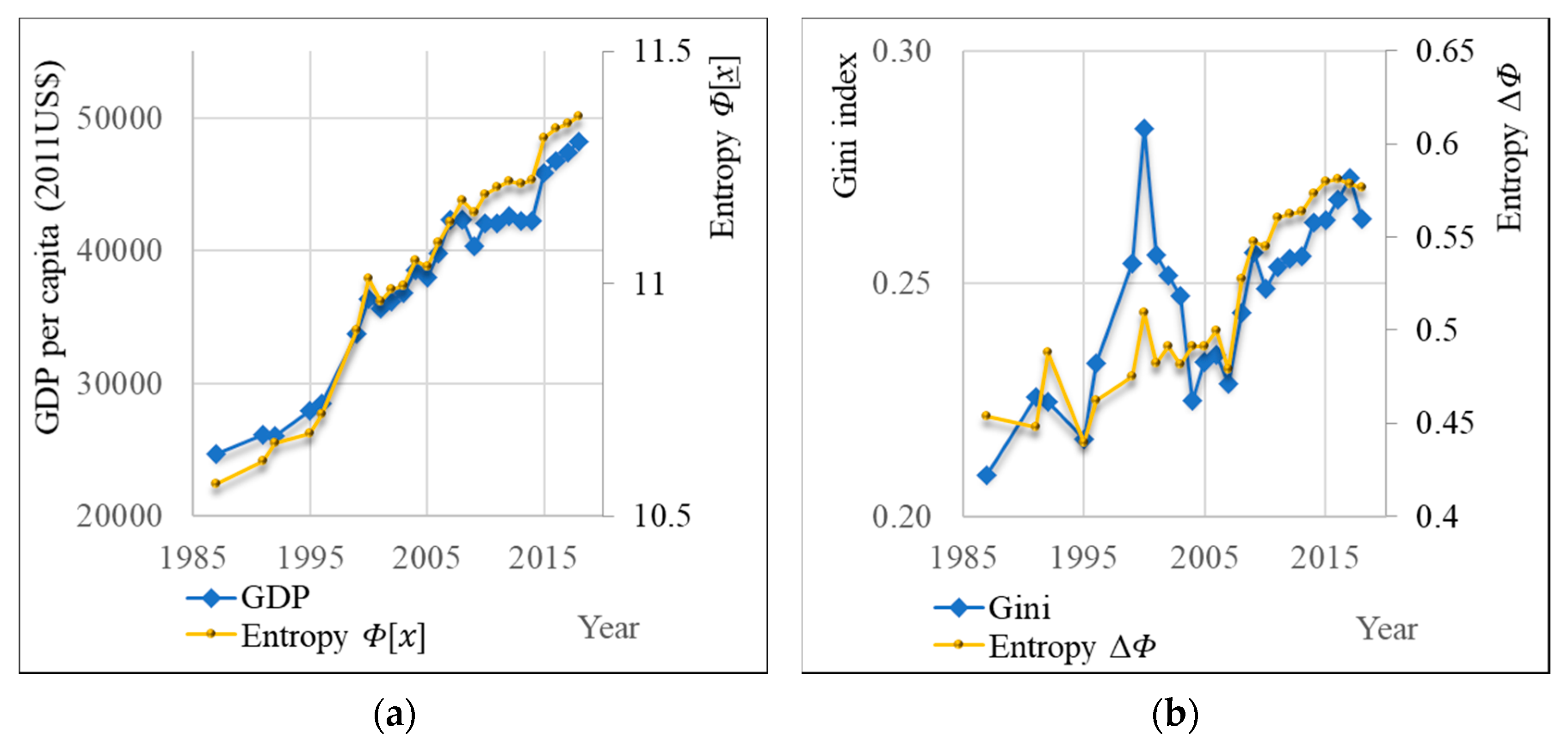
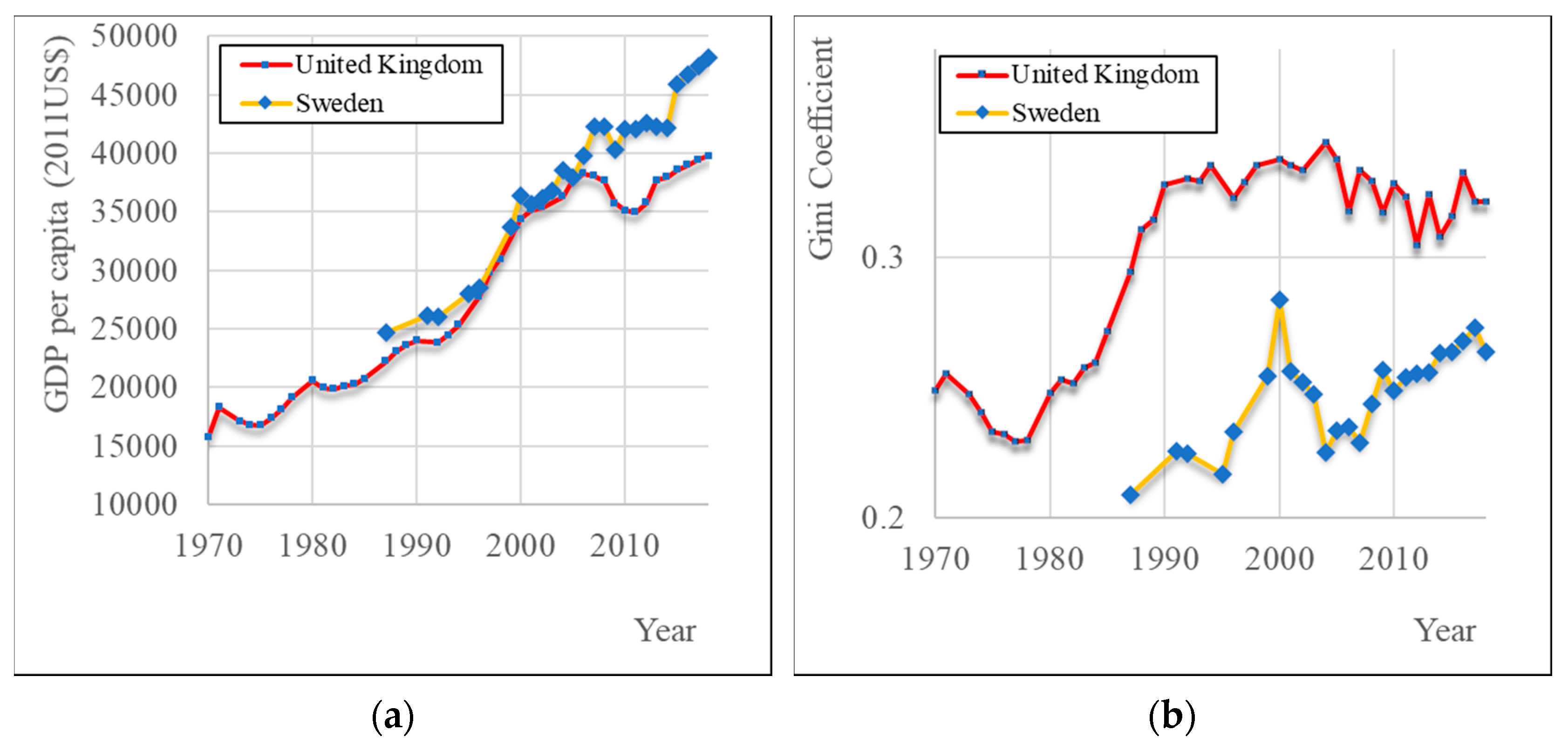
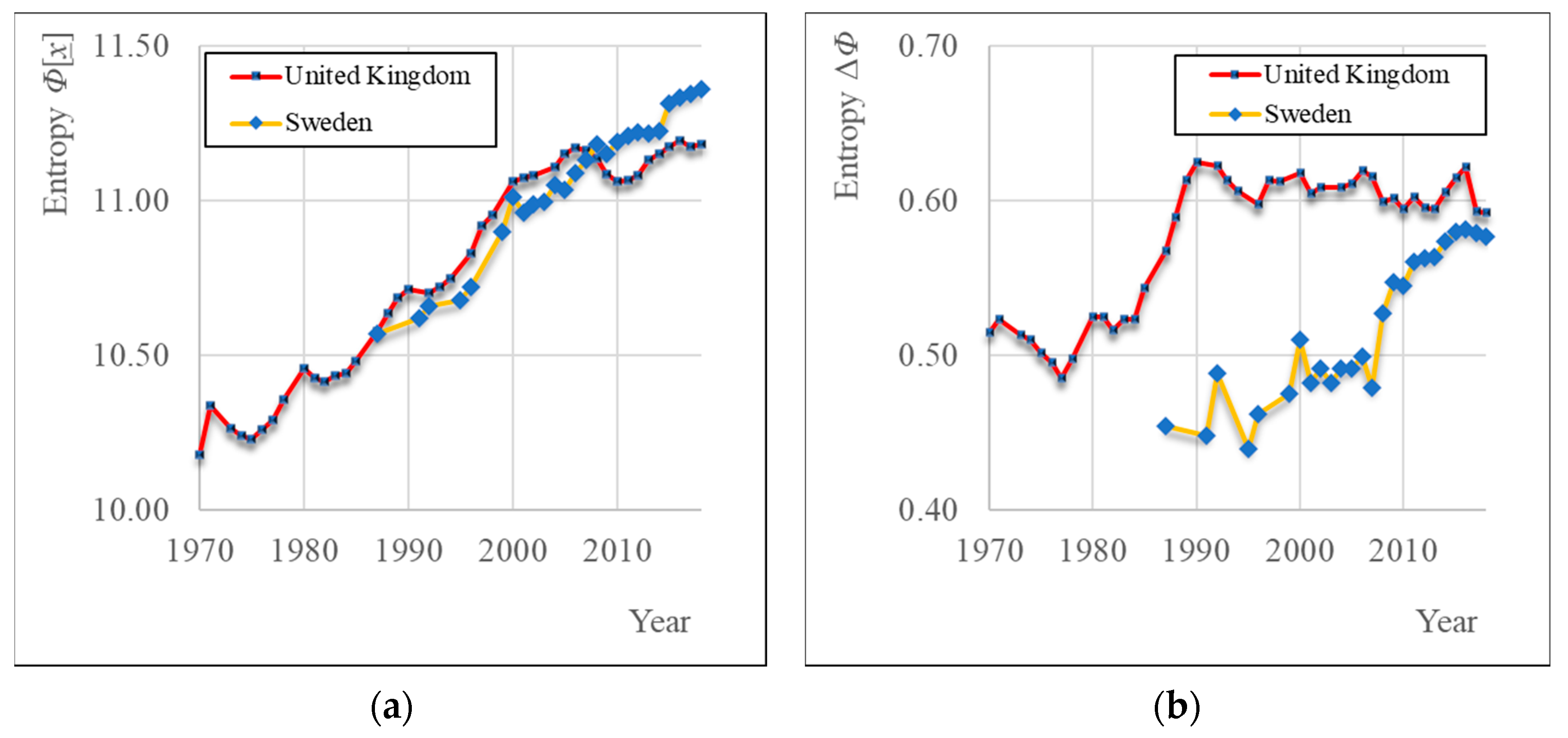
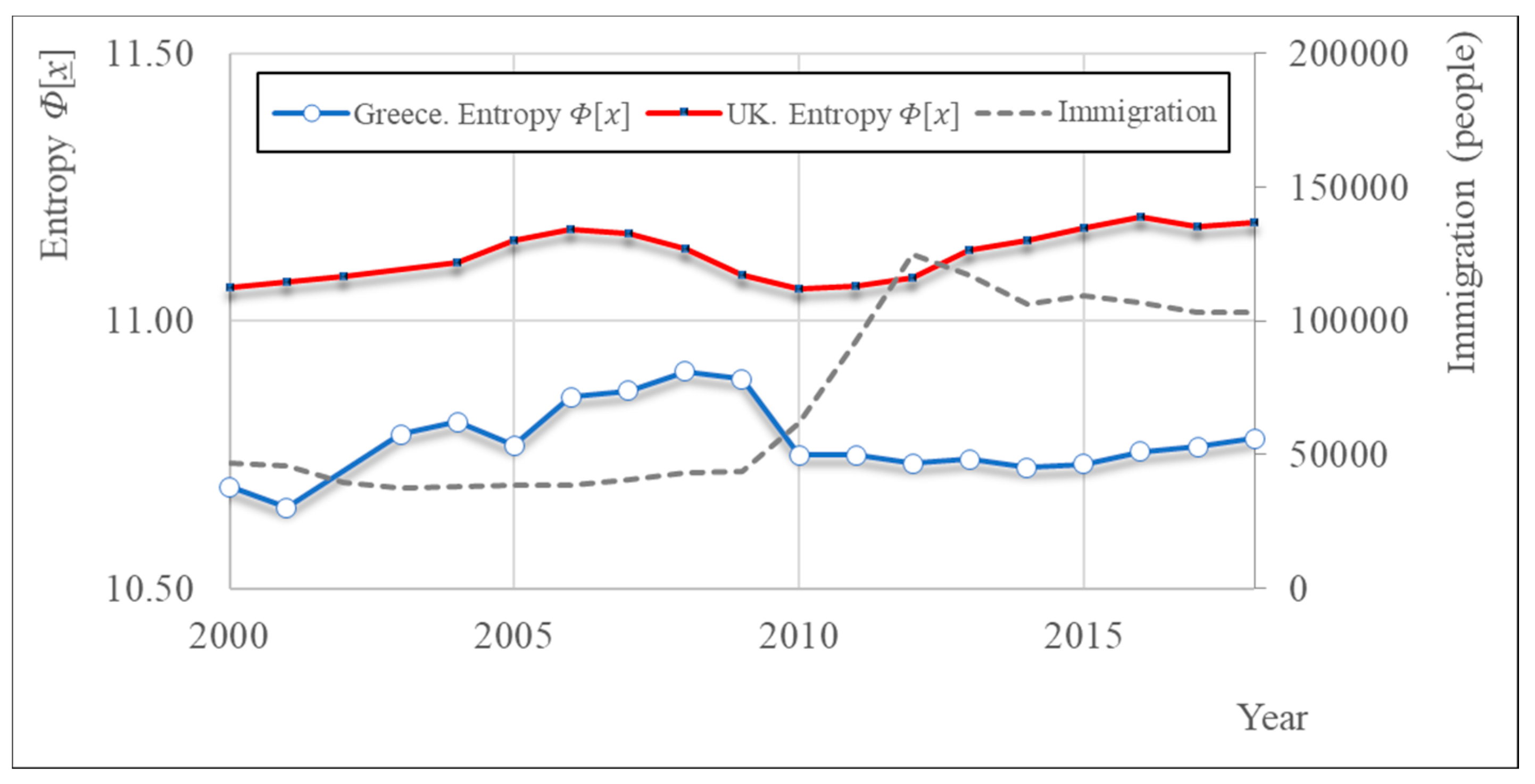
| Type of Living | Area (ha) | Energy Per Capita per Day for Food (kWh) |
|---|---|---|
| Hunter-Gatherers | 100 | 1 |
| Pastorals (pastoralism) | 2 | 2.50 |
| Granger (agriculture) | 1 | 3.50 |
Publisher’s Note: MDPI stays neutral with regard to jurisdictional claims in published maps and institutional affiliations. |
© 2021 by the authors. Licensee MDPI, Basel, Switzerland. This article is an open access article distributed under the terms and conditions of the Creative Commons Attribution (CC BY) license (https://creativecommons.org/licenses/by/4.0/).
Share and Cite
Sargentis, G.-F.; Iliopoulou, T.; Dimitriadis, P.; Mamassis, N.; Koutsoyiannis, D. Stratification: An Entropic View of Society’s Structure. World 2021, 2, 153-174. https://doi.org/10.3390/world2020011
Sargentis G-F, Iliopoulou T, Dimitriadis P, Mamassis N, Koutsoyiannis D. Stratification: An Entropic View of Society’s Structure. World. 2021; 2(2):153-174. https://doi.org/10.3390/world2020011
Chicago/Turabian StyleSargentis, G.-Fivos, Theano Iliopoulou, Panayiotis Dimitriadis, Nikolaos Mamassis, and Demetris Koutsoyiannis. 2021. "Stratification: An Entropic View of Society’s Structure" World 2, no. 2: 153-174. https://doi.org/10.3390/world2020011
APA StyleSargentis, G.-F., Iliopoulou, T., Dimitriadis, P., Mamassis, N., & Koutsoyiannis, D. (2021). Stratification: An Entropic View of Society’s Structure. World, 2(2), 153-174. https://doi.org/10.3390/world2020011









